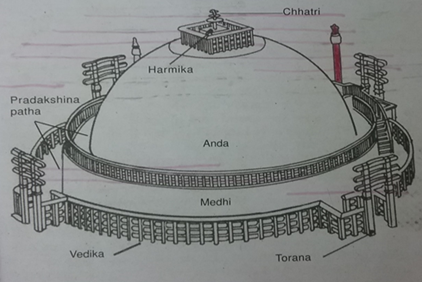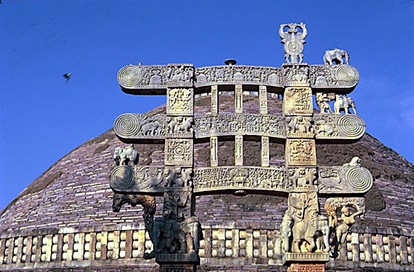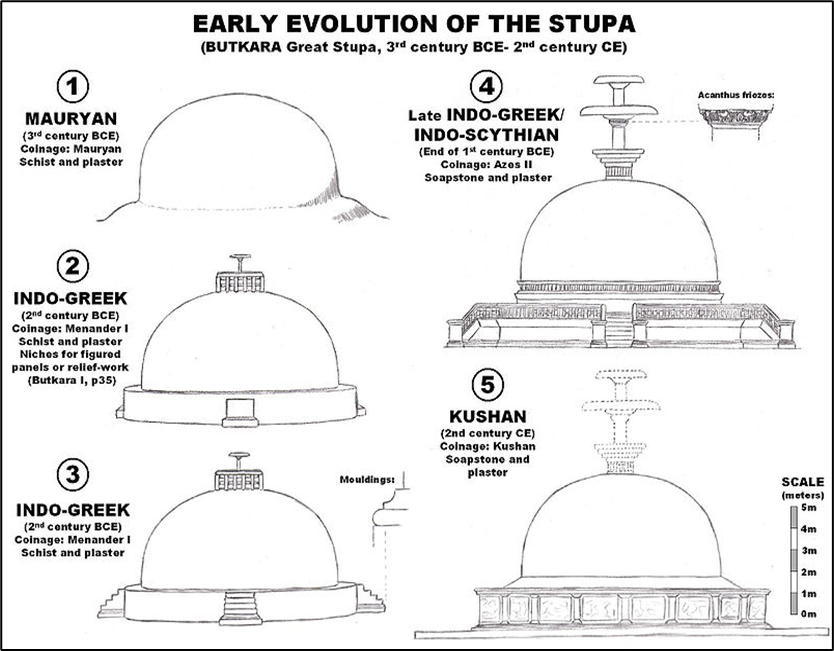Why in News?
During his recent visit to Germany, the External Affairs Minister of India paid a visit to the replica of Sanchi's Great Stupa's East Gate standing in front of Humboldt Forum Museum in Berlin.
What’s in Today’s Article?
- What is a Stupa?
- The Great Stupa of Sanchi
- The East Gate of the Sanchi Stupa and its Replica
What is a Stupa?
- Meaning: In Buddhism, a stupa is a mound-like or hemispherical structure containing relics (typically the remains of Buddha and other Buddhist monks or nuns) that is used as a place of meditation.
- Origin: Stupas were pre-Buddhist burial mounds in ancient India. They had no religious significance and were simply memorials that were less elaborate and conspicuous than they are today.
- Structure:
- Development:
- Expansion under Ashoka (250 BCE): According to Buddhist tradition, Emperor Ashoka recovered the relics of the Buddha from the earlier stupas and erected 84,000 stupas to distribute the relics across India.
- Decorated stupas (from 125 BCE): Stupas were soon to be richly decorated with sculptural reliefs. For example, Bharhut (115 BCE), Bodh Gaya (60 BCE), Mathura (125–60 BCE), Sanchi (for the elevation of the toranas), etc.
- Development in Gandhara (3rd century BCE - 5th century CE): Since Buddhism spread to Central Asia, China, Korea and Japan through Gandhara, the stylistic evolution of the Gandharan stupa was very influential.
- Significance: It is thought that the temple in the shape of a truncated pyramid may have derived from the design of the stepped stupas that developed in Gandhara. The Mahabodhi Temple in Bodh Gaya is one such example.
The Great Stupa of Sanchi:

- About:
- Commissioned in the 3rd century BCE by Emperor Ashoka, it is the oldest stone structure in India and is considered one of the best-preserved groups of Buddhist monuments in the country.
- It was built over the relics of Buddha and his two disciples - Sariputra and Maudgalyayan.
- The most recent construction in Sanchi can be dated to as late as the 12th century CE, after which the site was abandoned.
- British General Henry Taylor rediscovered the Sanchi Stupa in 1818 and Alexander Cunningham led the first formal survey and excavations at Sanchi in 1851.
- The site was restored to its present condition by ASI director-general John Marshall in the 1910s with funding from the begums of nearby Bhopal.
- It was designated as a UNESCO World Heritage Site in 1989.
- Location: It is located on a hilltop at Sanchi Town in Raisen District of the State of Madhya Pradesh.
- Significance: It provides a broad and instructive field for researching the origins, development, and decline of Buddhist art and architecture in India.
- Gateways/ Toranas of the Great Stupa
- While the original stupa was a plain hemispherical structure crowned by a chhatra (parasol), the 4 ornamental gateways or toranas (oriented to the four cardinal directions) were constructed in the first century BCE
- These were constructed within a few decades of each other during the reign of the Satavahana
- These gateways are made of two square pillars adorned with beautiful sculptures depicting scenes from the Buddha’s life (not the Buddha in his human form) and stories from the Jataka
- The art impresses immensely by its rhythm, symmetry, visual splendour and exquisite treatment of the flower and plant elements.
The East Gate of the Sanchi Stupa and its Replica:

- Features:
- The upper architrave of the gate represents the seven Manushi Buddhas (previous Buddhas, with the historical Buddha being the latest incarnation).
- The middle architrave depicts the scene of the Great Departure, when prince Siddhartha leaves Kapilavastu to live as an ascetic in search of enlightenment.
- The lower architrave depicts Emperor Ashoka visiting the Bodhi tree under which the Buddha attained enlightenment.
- Other decorative elements include the shalabhanjika (a fertility emblem represented by a yakshi grasping the branch of a tree), elephants, winged lions, and peacocks.
- Why is the East Gate the most famous of the Sanchi toranas in Europe?
- There is a historical reason behind this. The East Gate was cast in plaster by Lieutenant Henry Hardy Cole for the Victoria and Albert Museum (London, UK) in the late 1860s.
- Later, this cast was replicated and displayed all over Europe. The latest Berlin replica too traces its origin to this original cast.










